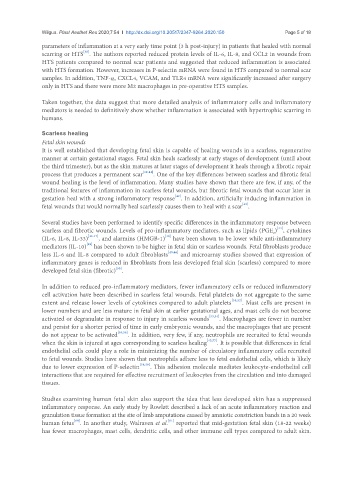Page 626 - Read Online
P. 626
Wilgus. Plast Aesthet Res 2020;7:54 I http://dx.doi.org/10.20517/2347-9264.2020.150 Page 5 of 18
parameters of inflammation at a very early time point (3 h post-injury) in patients that healed with normal
[38]
scarring or HTS . The authors reported reduced protein levels of IL-6, IL-8, and CCL2 in wounds from
HTS patients compared to normal scar patients and suggested that reduced inflammation is associated
with HTS formation. However, increases in P-selectin mRNA were found in HTS compared to normal scar
samples. In addition, TNF-α, CXCL4, VCAM, and TLR4 mRNA were significantly increased after surgery
only in HTS and there were more M2 macrophages in pre-operative HTS samples.
Taken together, the data suggest that more detailed analysis of inflammatory cells and inflammatory
mediators is needed to definitively show whether inflammation is associated with hypertrophic scarring in
humans.
Scarless healing
Fetal skin wounds
It is well established that developing fetal skin is capable of healing wounds in a scarless, regenerative
manner at certain gestational stages. Fetal skin heals scarlessly at early stages of development (until about
the third trimester), but as the skin matures at later stages of development it heals through a fibrotic repair
process that produces a permanent scar [39-41] . One of the key differences between scarless and fibrotic fetal
wound healing is the level of inflammation. Many studies have shown that there are few, if any, of the
traditional features of inflammation in scarless fetal wounds, but fibrotic fetal wounds that occur later in
[42]
gestation heal with a strong inflammatory response . In addition, artificially inducing inflammation in
[43]
fetal wounds that would normally heal scarlessly causes them to heal with a scar .
Several studies have been performed to identify specific differences in the inflammatory response between
[44]
scarless and fibrotic wounds. Levels of pro-inflammatory mediators, such as lipids (PGE ) , cytokines
2
[48]
(IL-6, IL-8, IL-33) [45-47] , and alarmins (HMGB-1) have been shown to be lower while anti-inflammatory
mediators (IL-10) has been shown to be higher in fetal skin or scarless wounds. Fetal fibroblasts produce
[49]
less IL-6 and IL-8 compared to adult fibroblasts [45,46] and microarray studies showed that expression of
inflammatory genes is reduced in fibroblasts from less developed fetal skin (scarless) compared to more
[50]
developed fetal skin (fibrotic) .
In addition to reduced pro-inflammatory mediators, fewer inflammatory cells or reduced inflammatory
cell activation have been described in scarless fetal wounds. Fetal platelets do not aggregate to the same
extent and release lower levels of cytokines compared to adult platelets [51,52] . Mast cells are present in
lower numbers and are less mature in fetal skin at earlier gestational ages, and mast cells do not become
activated or degranulate in response to injury in scarless wounds [53,54] . Macrophages are fewer in number
and persist for a shorter period of time in early embryonic wounds, and the macrophages that are present
do not appear to be activated [55,56] . In addition, very few, if any, neutrophils are recruited to fetal wounds
when the skin is injured at ages corresponding to scarless healing [42,57] . It is possible that differences in fetal
endothelial cells could play a role in minimizing the number of circulatory inflammatory cells recruited
to fetal wounds. Studies have shown that neutrophils adhere less to fetal endothelial cells, which is likely
due to lower expression of P-selectin [58,59] . This adhesion molecule mediates leukocyte-endothelial cell
interactions that are required for effective recruitment of leukocytes from the circulation and into damaged
tissues.
Studies examining human fetal skin also support the idea that less developed skin has a suppressed
inflammatory response. An early study by Rowlatt described a lack of an acute inflammatory reaction and
granulation tissue formation at the site of limb amputations caused by amniotic constriction bands in a 20 week
human fetus . In another study, Walraven et al. reported that mid-gestation fetal skin (18-22 weeks)
[60]
[61]
has fewer macrophages, mast cells, dendritic cells, and other immune cell types compared to adult skin.

